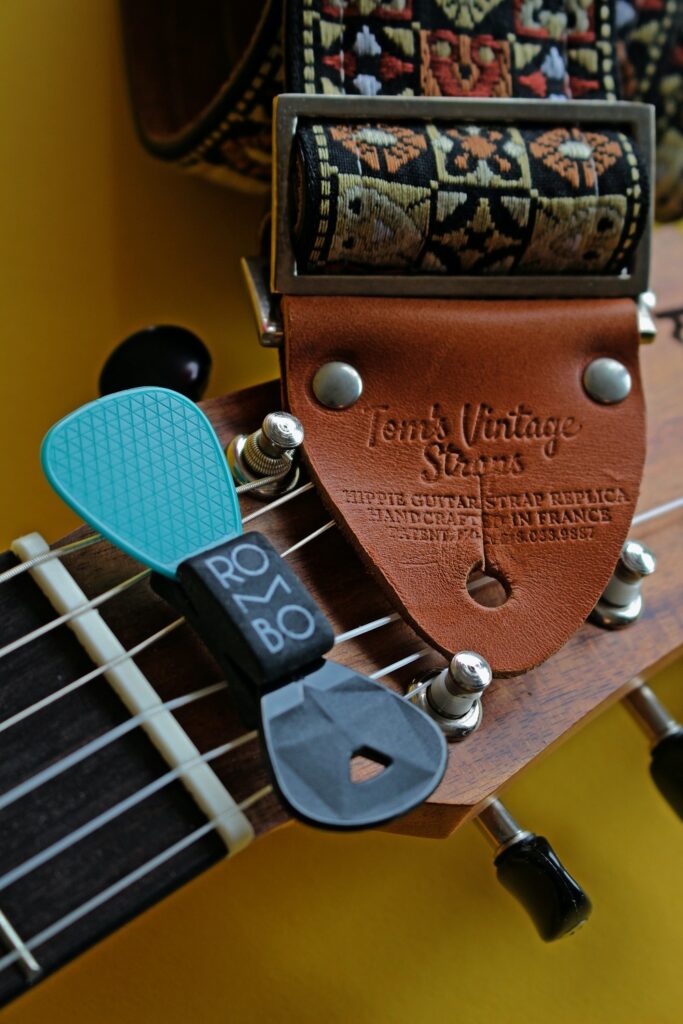
When it comes to playing the guitar, the right accessories can make a significant difference in your playing experience and performance. Two essential accessories for guitarists are picks and straps. Picks affect your tone and technique, while straps provide comfort and stability during playing. Choosing the right picks and straps for your guitar is important for optimizing your playing style and comfort. This article will guide you through the process of selecting the right picks and straps for your guitar.
Choosing Picks:
1. Material:
Picks come in various materials, including plastic, nylon, celluloid, metal, and even wood. Each material has its unique characteristics that can affect your tone and playing technique. Experimenting with different materials can help you find the pick that suits your playing style.
- Plastic picks: These are the most common and widely available. They come in different thicknesses and offer a balanced tone with flexibility for strumming and picking.
- Nylon picks: Nylon picks are similar to plastic but are known for their durability and enhanced grip. They produce a warmer tone and are preferred by many acoustic players.
- Celluloid picks: Celluloid picks are known for their vintage appeal and a wide range of colors and designs. They provide a smooth feel and produce a balanced tone.
- Metal picks: Metal picks offer a bright and articulate tone with increased durability. They are commonly used for heavy metal or shredding styles.
- Wood picks: Wood picks produce a warm and organic tone and are favored by acoustic players seeking a softer sound.
2. Thickness:
Picks come in various thicknesses, usually measured in millimeters. Thicker picks offer more resistance and are suitable for players who prefer a stiffer feel and more precise picking. Thinner picks provide flexibility and are ideal for strumming and rhythm playing. Experiment with different thicknesses to find the one that feels most comfortable and suits your playing style.
3. Shape:
Picks come in different shapes, such as standard teardrop, triangle, jazz, and sharkfin. The shape can affect your grip and the way the pick interacts with the strings. Experiment with different shapes to find one that allows for comfortable handling and precise control.
Choosing Straps:
1. Length:
The length of a guitar strap is an important consideration for finding the right fit and comfort. Adjustable straps are widely available, allowing you to customize the length according to your preference. Consider factors such as your playing position and body size to ensure the strap allows for proper playing posture and instrument positioning.
2. Width and Padding:
Strap width and padding play a crucial role in providing comfort, especially during long playing sessions. Wider straps distribute the weight of the guitar more evenly across your shoulder, reducing strain and discomfort. Some straps also feature padding for added comfort. Consider the weight of your guitar and personal comfort preferences when selecting the width and padding of your strap.
3. Material and Style:
Guitar straps are available in various materials, including leather, nylon, fabric, and suede. Each material offers different aesthetics, durability, and comfort levels. Leather straps provide a classic and durable option, while nylon and fabric straps are lightweight and often feature colorful designs. Consider your personal style preferences, durability needs, and comfort when choosing the material and style of your strap.
4. Strap Locks:
Strap locks are optional accessories that can provide additional security by preventing the strap from accidentally detaching from the guitar. They are particularly useful for live performances or vigorous playing. Strap locks come in different designs and can be easily attached to your guitar.
5. Ergonomics and Weight Distribution:
When trying out different straps, pay attention to the overall ergonomics and weight distribution. A well-designed strap should evenly distribute the weight of the guitar across your body to prevent strain on your neck and shoulders. Look for straps with adjustable features that allow you to find the most comfortable position for your playing style and body type.
6. Consider Your Playing Style:
Your playing style can also influence the choice of strap. If you’re an energetic performer who likes to move around on stage, a strap with a non-slip surface or built-in grip can help keep your guitar in place. If you play in a seated position or prefer a lower-slung guitar, a longer strap may be necessary to achieve the desired height.
7. Try Before You Buy:
Whenever possible, it’s beneficial to try out different picks and straps before making a purchase. Visit a local music store or borrow from fellow guitarists to test out various options. This hands-on approach allows you to feel the comfort, grip, and sound produced by different picks and experience the fit and adjustability of different straps.
8. Personal Preference:
Ultimately, the choice of picks and straps is a matter of personal preference. It’s essential to find picks and straps that feel comfortable, inspire confidence, and enhance your playing experience. Experiment with different combinations to discover the picks and straps that suit your unique playing style, genre, and aesthetic preferences.
Remember, the right picks and straps can make a noticeable difference in your playing comfort, technique, and tone. Take the time to explore the options available, consider your playing style and genre, and prioritize comfort and functionality when making your selections. By finding the perfect picks and straps for your guitar, you can optimize your playing experience and enjoy hours of comfortable and inspired playing.
Generated by ChatGPT